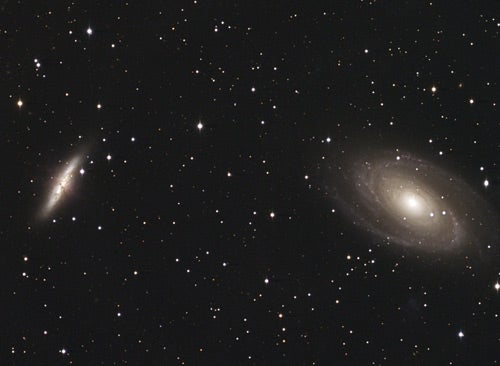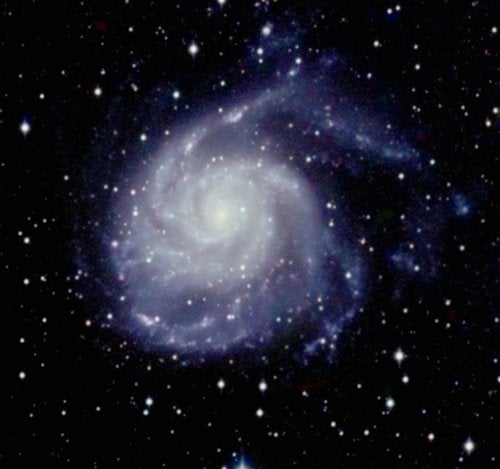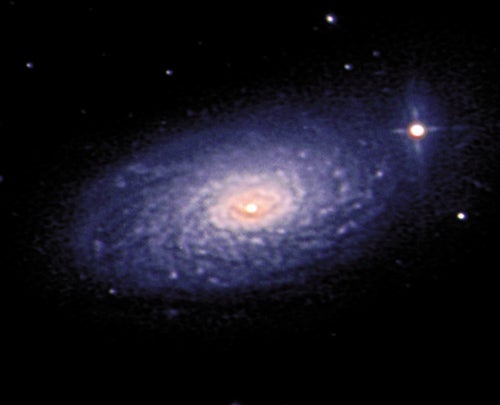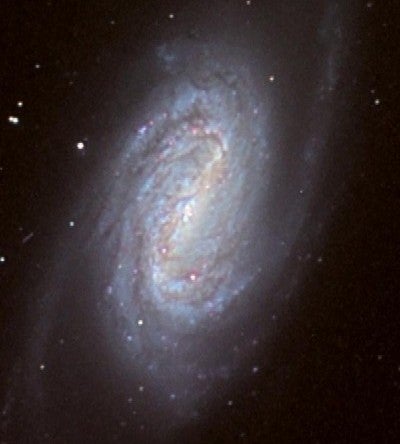Mizar
Let’s start with an easy target. Look high in the northeast. At the bend of the Big Dipper’s handle, you’ll find the star Mizar. Nearby, and visible to most observers without optical aid, is Alcor. But point a small telescope at Mizar, and you’ll split that star into two components. The brighter of the two outshines its partner by nearly 5 times.
Let’s start with an easy target. Look high in the northeast. At the bend of the Big Dipper’s handle, you’ll find the star Mizar. Nearby, and visible to most observers without optical aid, is Alcor. But point a small telescope at Mizar, and you’ll split that star into two components. The brighter of the two outshines its partner by nearly 5 times.
If you are viewing from mid-northern latitudes, the constellation Ursa Major, the Great Bear, rides high overhead on spring evenings. Located far from obscuring dust clouds, Ursa Major is a picture window into the universe’s depths. While hundreds of galaxies lie within its borders, only a few are in the range of most binoculars. M81 (right) and M82 (left) are two of these challenging exceptions.
Christian Viladrich
M81 and M82
Above and to the northwest of the Big Dipper’s bowl, you’ll find our first two galactic targets: M81 and M82. Through your lowest-power eyepiece, you may be able to spot both of these galaxies at once.
Above and to the northwest of the Big Dipper’s bowl, you’ll find our first two galactic targets: M81 and M82. Through your lowest-power eyepiece, you may be able to spot both of these galaxies at once.
M81 is a spiral galaxy, but its arms lie close to its core. A 4-inch telescope won’t allow you to see them well.
M82 lies half a degree north of M81. Astronomers call this galaxy, which seems to be exploding, a starburst galaxy. Here, you’ll find much more than a galaxy’s normal amount of star formation. Look closely at these two objects. M81 is brighter, but M82 is easier to see because its surface brightness is greater than M81’s. That means its light isn’t spread out over such a large area.
Owl Nebula (M97)
Head back just below the Big Dipper’s bowl to find the Owl Nebula, also known as M97. This large, round planetary nebula has two dark spots, giving the object the appearance of an owl’s face. You’ll need a dark site to pick out the low-contrast eyes. Be patient, and try all your eyepieces.
Head back just below the Big Dipper’s bowl to find the Owl Nebula, also known as M97. This large, round planetary nebula has two dark spots, giving the object the appearance of an owl’s face. You’ll need a dark site to pick out the low-contrast eyes. Be patient, and try all your eyepieces.
M101
Our next object makes a nice triangle with the two stars at the end of the Dipper’s handle. It’s spiral galaxy M101. Through a small scope, you’ll see this object as large and round. Increase the magnification as much as sky conditions allow, and look for faint dark streaks within the circle. Those areas divide M101’s spiral arms.
Our next object makes a nice triangle with the two stars at the end of the Dipper’s handle. It’s spiral galaxy M101. Through a small scope, you’ll see this object as large and round. Increase the magnification as much as sky conditions allow, and look for faint dark streaks within the circle. Those areas divide M101’s spiral arms.
The Whirlpool Galaxy (M51)
Next on our list is one of the sky’s true wonders — the Whirlpool Galaxy, also known as M51. To find it, start at the end of the Big Dipper’s handle and move 3 degrees southwest. Take your time observing the Whirlpool Galaxy. Note its bright core and the two main spiral arms. At most magnifications, you’ll also see M51’s companion galaxy, NGC 5195.
Next on our list is one of the sky’s true wonders — the Whirlpool Galaxy, also known as M51. To find it, start at the end of the Big Dipper’s handle and move 3 degrees southwest. Take your time observing the Whirlpool Galaxy. Note its bright core and the two main spiral arms. At most magnifications, you’ll also see M51’s companion galaxy, NGC 5195.
The Sunflower Galaxy
Now move a bit more than 5° south of M51 to find the Sunflower Galaxy, also called M63. Through a 4-inch scope, look for an oval halo that surrounds a bright core. Although M63 is a spiral galaxy, you won’t see its tightly wound spiral arms until you triple the size of your instrument.
Now move a bit more than 5° south of M51 to find the Sunflower Galaxy, also called M63. Through a 4-inch scope, look for an oval halo that surrounds a bright core. Although M63 is a spiral galaxy, you won’t see its tightly wound spiral arms until you triple the size of your instrument.
M67
Head over to Cancer the Crab next to observe open cluster M67. This cluster lies just outside the range of most observers’ vision but appears easily through binoculars. Through a 4-inch telescope, M67 appears compact. You’ll resolve a dozen or so of its stars.
Head over to Cancer the Crab next to observe open cluster M67. This cluster lies just outside the range of most observers’ vision but appears easily through binoculars. Through a 4-inch telescope, M67 appears compact. You’ll resolve a dozen or so of its stars.
NGC 2903
Our next object, barred spiral galaxy NGC 2903, lies not quite 4° southwest of the 3rd-magnitude star Epsilon Leonis. It shines at a relatively bright magnitude 8.9, but you can’t see most of its details through small telescopes. Astronomers classify NGC 2903 as a “hotspot” galaxy, a term that describes a ring of infrared-luminous knots near a galaxy’s core. Through a 4-inch scope, look for the brighter bar surrounded by an ephemeral haze.
Our next object, barred spiral galaxy NGC 2903, lies not quite 4° southwest of the 3rd-magnitude star Epsilon Leonis. It shines at a relatively bright magnitude 8.9, but you can’t see most of its details through small telescopes. Astronomers classify NGC 2903 as a “hotspot” galaxy, a term that describes a ring of infrared-luminous knots near a galaxy’s core. Through a 4-inch scope, look for the brighter bar surrounded by an ephemeral haze.
Algeiba
Before you leave Leo, head to the double star Algeiba, also known as Gamma Leonis. Insert an eyepiece that gives a magnification of 100x or more, and you’ll separate this star into two components. One shines at magnitude 2.3, while the other is slightly fainter, glowing at magnitude 3.5. Algeiba makes a fine sight through small telescopes.
Before you leave Leo, head to the double star Algeiba, also known as Gamma Leonis. Insert an eyepiece that gives a magnification of 100x or more, and you’ll separate this star into two components. One shines at magnitude 2.3, while the other is slightly fainter, glowing at magnitude 3.5. Algeiba makes a fine sight through small telescopes.
The Sombrero Galaxy (M104)
The final object on our list is the Sombrero Galaxy, also known as M104. This object’s lens shape and the dark dust lane that splits it are easy to spot through any telescope. As you observe M104, note that the galaxy’s two sections have unequal brightnesses. The northern half outshines the southern because the galaxy inclines 6° to our line of sight. Through a 4-inch telescope, you may detect the dust lane only near the Sombrero’s center. The core is large and bright. Try to pick out the large halo that surrounds it.
The final object on our list is the Sombrero Galaxy, also known as M104. This object’s lens shape and the dark dust lane that splits it are easy to spot through any telescope. As you observe M104, note that the galaxy’s two sections have unequal brightnesses. The northern half outshines the southern because the galaxy inclines 6° to our line of sight. Through a 4-inch telescope, you may detect the dust lane only near the Sombrero’s center. The core is large and bright. Try to pick out the large halo that surrounds it.













